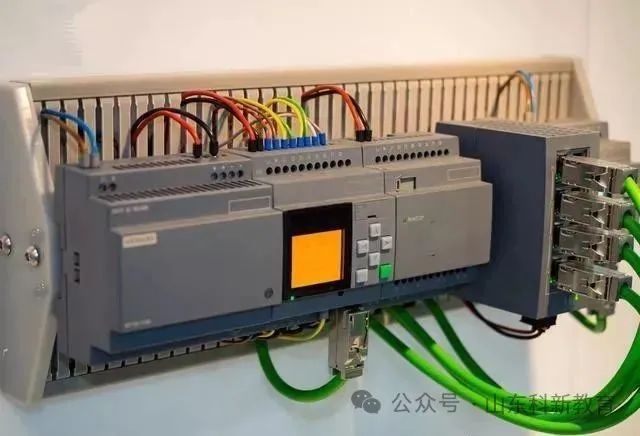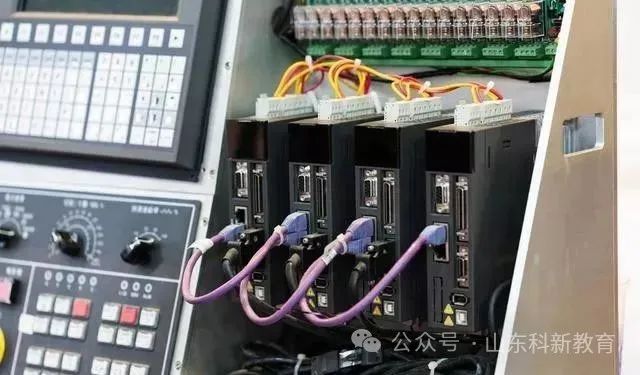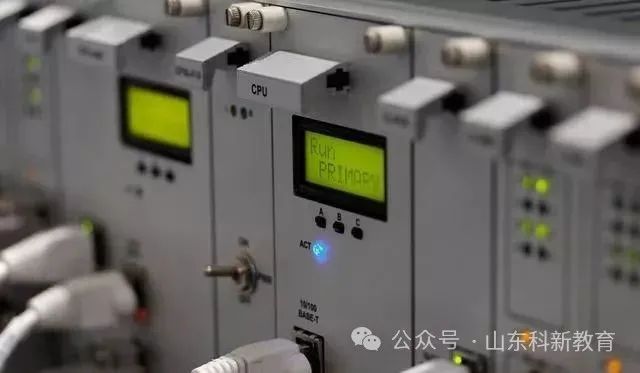16 Basic Knowledge of PLC
Anyone engaged in electrical work knows that industrial production and technological development cannot be separated from the automation control of PLCs. PLC can be broadly understood as: a centralized relay extension control cabinet. In practical production applications, PLC greatly saves the cost of industrial control and enhances the centralized management and automatic control of equipment. To learn PLC well, a solid foundation in PLC is essential.

1
From the composition of PLC, besides CPU, memory, and
communication interfaces, what other interfaces are directly related to the industrial site? Explain their main functions.
(1) Input Interface: Accepts signals from controlled devices and drives the internal circuit to connect or disconnect through optocoupler devices and input circuits.
(2) Output Interface: The execution results of the program are output through the optocoupler devices of the output interface and output components (relays, thyristors, transistors), controlling the connection or disconnection of external loads.
2
What are the basic units of PLC composed of? What roles do they play?
(1) CPU: The core component of PLC, directing PLC to perform various tasks, such as receiving user programs and data, diagnostics, and executing programs;
(2) Memory: Stores system and user programs and data;
(3) I/O Interface: The connecting component between PLC and the controlled objects in the industrial production site, used to receive signals from controlled devices and output the results of program execution;
(4) Communication Interface: Exchanges information with other devices such as monitors and printers through the communication interface;
(5) Power Supply.

3
What types of PLC digital output interfaces are there? What are their characteristics?
Thyristor Output Type: Generally, it can only carry AC loads, with fast response speed and high action frequency;
Transistor Output Type: Generally, it can only carry DC loads, with fast response speed and high action frequency;
Relay Output Type: Generally, it can carry both AC and DC loads, but its response time is long, and action frequency is low.
4
What types of PLC are there according to structural types? What are their characteristics?
(1) Integrated Type: All components including CPU, power supply, and I/O components are concentrated in one chassis, compact structure, low price; generally used for small PLCs;
(2) Modular Type: Divides the various parts of PLC into several separate modules, allowing flexible configuration and easy expansion and maintenance; generally used for medium and large PLCs. Modular PLC consists of a frame or base and various modules, with modules installed in sockets on the frame or base.
(3) Stacked Type: Combines the characteristics of both integrated and modular types. The CPU, power supply, and I/O interfaces of stacked PLC are also independent modules, but they are connected by cables, making the system both flexible in configuration and compact in size.
5
What is the scanning cycle of PLC? What mainly affects it?
The scanning process of PLC includes five stages: internal processing, communication service, input processing, program execution, and output processing. The time required to scan through these five stages once is called the scanning cycle.
The scanning cycle is related to the CPU running speed, PLC hardware configuration, and the length of the user program.

6
How does PLC execute user programs? What stages does the user program execution process include?
PLC executes user programs using a cyclic scanning method. The user program execution process includes the input sampling stage, program execution stage, and output refresh stage.
7
What advantages does PLC control system have compared to relay control system?
(1) In terms of control methods: PLC uses programmed methods for control, making it easy to change or add control requirements, and PLC contacts are unlimited;
(2) In terms of working methods: PLC uses a serial working method, improving the system’s anti-interference ability;
(3) In terms of control speed: PLC contacts are essentially triggers, and the execution time of instructions is in the microsecond range;
(4) In terms of timing and counting: PLC uses semiconductor integrated circuits as timers, with clock pulses provided by crystal oscillators, offering high delay accuracy and wide range. PLC has counting functions that relay systems do not possess;
(5) In terms of reliability and maintainability: PLC uses micro-electronic technology, has high reliability, and its self-diagnostic functions can promptly identify faults, while monitoring functions facilitate debugging and maintenance.
8
What causes the output response lag phenomenon in PLC? How can I/O response speed be improved?
Because PLC adopts a centralized sampling and centralized output cyclic scanning working method, the status of the input can only be read during the input sampling stage of each scanning cycle, and the results of program execution can only be sent out during the output refresh stage; moreover, the input and output delays of PLC, the length of the user program, etc., can all cause output response lag.
To improve I/O response speed, various methods can be adopted, such as direct input sampling, output refresh, interrupt input/output, and intelligent I/O interfaces.
9
What types of internal soft relays are there in the FX0N series PLC?
Input relays, output relays, auxiliary relays, status registers, timers, counters, data registers.

10
How to choose a PLC?
1) Model selection: Should consider structural form, installation method, functional requirements, response speed, reliability requirements, and model unification;
2) Capacity selection: Should consider the number of I/O points and user storage capacity;
3) I/O module selection: Includes the selection of digital and analog I/O modules, as well as special function modules;
4) Selection of power modules and programming devices and other equipment.
11
Briefly describe the characteristics of the centralized sampling and centralized output working method of PLC. What are the advantages and disadvantages of adopting this working method?
Centralized Sampling: Within a scanning cycle, the sampling of input states occurs only during the input sampling stage, and the input end will be locked once it enters the program execution stage.
Centralized Output: Within a scanning cycle, the output status is only transferred from the output image register to the output latch during the output refresh stage, refreshing the output interface, while the output status remains in the output image register during other stages. Adopting this working method can improve the system’s anti-interference ability and enhance reliability, but it may cause lag in PLC input/output response.
12
What working methods does PLC adopt? What are their characteristics?
PLC adopts centralized sampling, centralized output, and cyclic scanning working methods.
Characteristics:
Centralized Sampling means that within a scanning cycle, PLC samples the input state only during the input sampling stage, and the input end will be locked once it enters the program execution stage.
Centralized Output means that within a scanning cycle, PLC only transfers the output status related to the output from the output image register to the output latch during the output refresh stage, refreshing the output interface while the output status remains in the output image register during other stages.
Cyclic Scanning means that PLC needs to execute multiple operations within a scanning cycle, using a time-sharing scanning method to execute them sequentially and repeat the process.

13
What are the main components of an electromagnetic contactor? Briefly describe the working principle of the electromagnetic contactor.
An electromagnetic contactor generally consists of an electromagnetic mechanism, contacts, arc extinguishing device, releasing spring mechanism, support, and base. The contactor works based on electromagnetic principles: when the electromagnetic coil is powered, the coil current generates a magnetic field, which causes the static iron core to attract the armature, driving the contacts to act, opening the normally closed contacts and closing the normally open contacts. These actions are linked. When the coil is powered off, the electromagnetic force disappears, and the armature drops under the action of the releasing spring, restoring the contacts, meaning the normally open contacts open and the normally closed contacts close.
14
Briefly describe the definition of a Programmable Logic Controller (PLC).
A Programmable Logic Controller (PLC) is an electronic device designed for digital operation in industrial environments. It uses programmable memory to store instructions for performing logical operations, sequential operations, timing, counting, and arithmetic operations, and can control various types of machinery or production processes through digital or analog inputs and outputs.
PLCs and their related peripheral devices should be designed based on the principles of easy integration into an industrial control system and ease of functional expansion.
15
Briefly explain the differences in working principles between PLC systems and relay contactor systems.
The components are different;
The number of contacts is different;
The methods of implementing control are different;
The working methods are different.

16
What are the characteristics of the STL step ladder instructions of the Mitsubishi FX 2N series PLC?
(1) The transfer source is automatically reset;
(2) Allows dual output;
(3) Main control function.
Source: This article is reproduced from the internet, copyright belongs to the original author. If there are copyright issues, please contact us promptly for deletion, thank you!

Scan to Follow
WeChat ID|13615417996
Follow the QR code on the left to get
[Siemens Data Collection] for free.